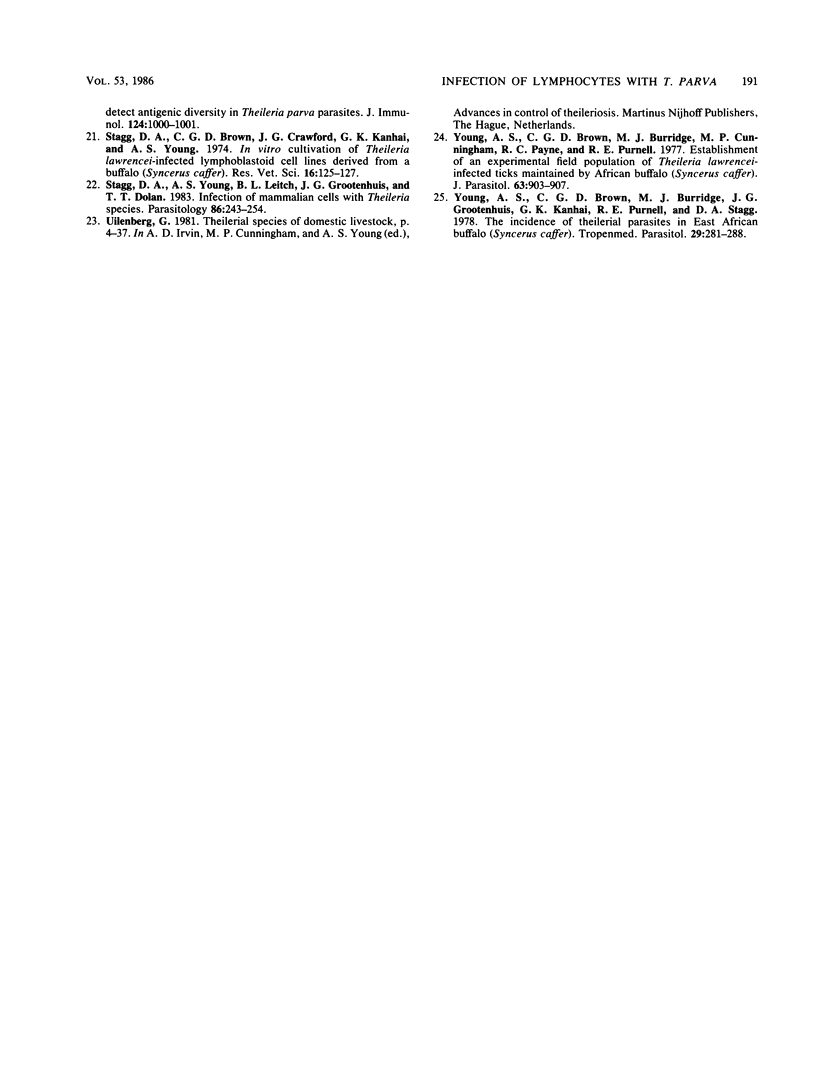Abstract
This study compared infection and transformation of peripheral blood mononuclear cells (PBM) of Boran cattle and African buffalo in vitro to determine whether differences occurred which could account for the greater susceptibility of Boran cattle to infection with Theileria parva subsp. parva and T. parva subsp. lawrencei. PBM from buffalo and cattle had a similar percentage of cells which bound T. parva subsp. parva sporozoites (24 to 34%) and in which schizonts developed during the first week after infection (18 to 23%). Using a limiting dilution culture system, it was established, however, that a significantly higher proportion of cattle PBM transformed into continuously replicating cell lines after infection with T. parva subsp. parva than did buffalo PBM. The evidence suggests that the low capacity of T. parva subsp. parva to establish infections in buffalo compared with cattle is related to the lower frequency of buffalo cells which undergo transformation. With T. parva subsp. lawrencei, however, the frequency of transformation of buffalo PBM was higher than that for cattle PBM. The frequency of cells transformed by T. parva subsp. lawrencei, therefore, cannot account for the greater resistance of buffalo to infections with T. parva subsp. lawrencei. Buffalo must have other mechanisms, either innate or acquired, which control infection with T. parva subsp. lawrencei more efficiently than in cattle.
Full text
PDF





Selected References
These references are in PubMed. This may not be the complete list of references from this article.
- Brown C. G., Stagg D. A., Purnell R. E., Kanhai G. K., Payne R. C. Letter: Infection and transformation of bovine lymphoid cells in vitro by infective particles of Theileria parva. Nature. 1973 Sep 14;245(5420):101–103. doi: 10.1038/245101a0. [DOI] [PubMed] [Google Scholar]
- Burridge M. J., Young A. S., Stagg D. A., Kanhai G. K., Kimber C. D. Theileria lawrencei infection of cattle and African buffalo: evaluation of a buffalo cell culture schizont antigen for the indirect fluorescent antibody test. Res Vet Sci. 1974 Nov;17(3):285–289. [PubMed] [Google Scholar]
- Büscher G., Morrison W. I., Nelson R. T. Titration in cattle of infectivity and immunogenicity of autologous cell lines infected with Theileria parva. Vet Parasitol. 1984 Jul;15(1):29–38. doi: 10.1016/0304-4017(84)90107-9. [DOI] [PubMed] [Google Scholar]
- Cunningham M. P., Brown C. G., Burridge M. J., Irvin A. D., Purnell R. E., Radley D. E. Theileria parva: comparative infectivity of a ground tick stabilate and a classical 10-tick challenge. Res Vet Sci. 1973 Sep;15(2):263–265. [PubMed] [Google Scholar]
- Dobbelaere D. A., Spooner P. R., Barry W. C., Irvin A. D. Monoclonal antibody neutralizes the sporozoite stage of different Theileria parva stocks. Parasite Immunol. 1984 Jul;6(4):361–370. doi: 10.1111/j.1365-3024.1984.tb00808.x. [DOI] [PubMed] [Google Scholar]
- Fazekas de St Groth The evaluation of limiting dilution assays. J Immunol Methods. 1982 Mar 12;49(2):R11–R23. doi: 10.1016/0022-1759(82)90269-1. [DOI] [PubMed] [Google Scholar]
- HULLIGER L., WILDE K. H., BROWN C. G., TURNER L. MODE OF MULTIPLICATION OF THEILERIA IN CULTURES OF BOVINE LYMPHOCYTIC CELLS. Nature. 1964 Aug 15;203:728–730. doi: 10.1038/203728a0. [DOI] [PubMed] [Google Scholar]
- Kurtti T. J., Munderloh U. G., Irvin A. D., Büscher G. Theileria parva: early events in the development of bovine lymphoblastoid cell lines persistently infected with macroschizonts. Exp Parasitol. 1981 Oct;52(2):280–290. doi: 10.1016/0014-4894(81)90083-7. [DOI] [PubMed] [Google Scholar]
- Minami T., Spooner P. R., Irvin A. D., Ocama J. G., Dobbelaere D. A., Fujinaga T. Characterisation of stocks of Theileria parva by monoclonal antibody profiles. Res Vet Sci. 1983 Nov;35(3):334–340. [PubMed] [Google Scholar]
- Newson J., Naessens J., Stagg D. A., Black S. J. A cell surface antigen associated with Theileria parva lawrencei-infected bovine lymphoid cells. Parasite Immunol. 1986 Mar;8(2):149–158. doi: 10.1111/j.1365-3024.1986.tb00841.x. [DOI] [PubMed] [Google Scholar]
- Pinder M., Hewett R. S. Monoclonal antibodies detect antigenic diversity in Theileria parva parasites. J Immunol. 1980 Feb;124(2):1000–1001. [PubMed] [Google Scholar]
- Stagg D. A., Brown C. G., Crawford J. G., Kanhai G. K., Young A. S. In vitro cultivation of Theileria lawrencei-infected lymphoblastoid cell lines derived from a buffalo (Syncerus caffer). Res Vet Sci. 1974 Jan;16(1):125–127. [PubMed] [Google Scholar]
- Stagg D. A., Young A. S., Leitch B. L., Grootenhuis J. G., Dolan T. T. Infection of mammalian cells with Theileria species. Parasitology. 1983 Apr;86(Pt 2):243–254. doi: 10.1017/s0031182000050411. [DOI] [PubMed] [Google Scholar]
- Young A. S., Brown C. G., Burridge M. J., Cunningham M. P., Payne R. C., Purnell R. E. Establishment of an experimental field population of Theileria lawrencei-infected ticks maintained by African buffalo (Syncerus Caffer). J Parasitol. 1977 Oct;63(5):903–907. [PubMed] [Google Scholar]
- Young A. S., Brown C. G., Burridge M. J., Grootenhuis J. G., Kanhai G. K., Purnell R. E., Stagg D. A. The incidence of theilerial parasites in East African buffalo (Syncerus caffer). Tropenmed Parasitol. 1978 Sep;29(3):281–288. [PubMed] [Google Scholar]


